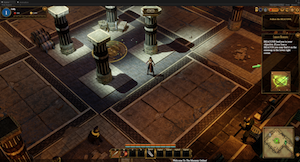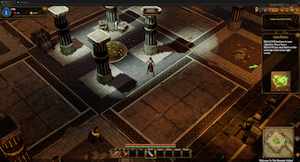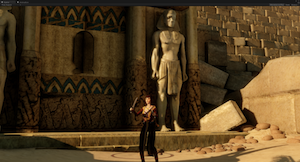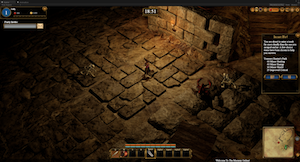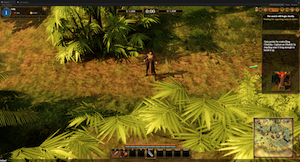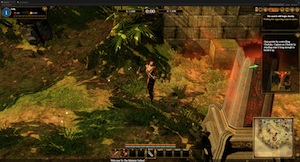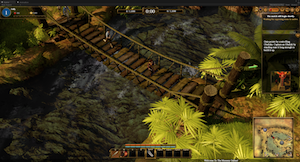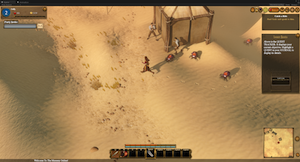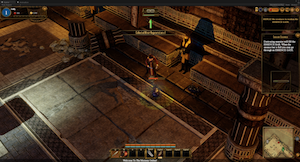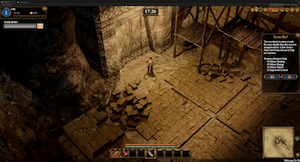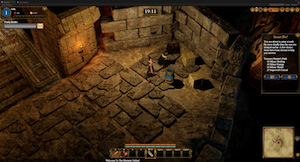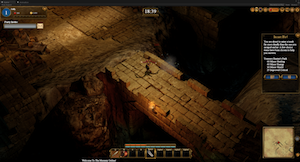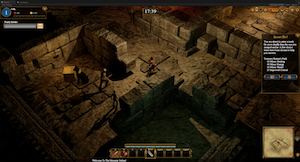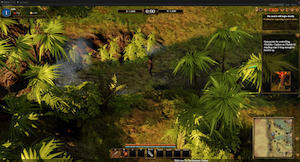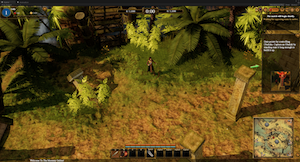The Mummy Online 2011-2012 Bigpoint Inc.
Abstract
A 3D browser based MMORPG developed in Unity. Worked with a medium sized team over the course of almost a year and a half. My primary responsibility was graphics programming, including all shader and level of detail implementation. At the beginning of the project I was also one of only two engineers who had experience with Unity, so I was heavily involved in the design of the initial architecture and development of design tools. I worked closely with the artists to make sure that their work was represented clearly within the game and provided them with the engineering support needed for the effects that they envisioned.
The art direction called for film-like realism to match the movie that the game is based on. For broad appeal, it needed to make good use of current generation hardware, yet still be able to run playably on low-end integrated GPUs. I decided to create two render paths to make this possible, one using full realtime lighting and one using mostly prebaked lighting. Since this is a browser based title, art assets also needed to be reused as much as possible, and streamed in only when needed.
Production was cancelled just as the game was about to leave beta. For the time being it will be left online with minimal maintenance support.
Implementation
Unity deferred prepass lighting was used with modifications in the high detail lighting mode, with indirect illumination stored in low resolution lightmaps for static geometry and lightprobes for dynamic objects. For the low detail mode, all static lighting was baked into a separate set of lightmaps and dynamic lights are forward rendered. This lead to some unresolved problems with color consistency in Unity 3.4 builds (which the current live version is still based on), as Unity's rendering pipeline is not easily customized. The Unity 3.5 builds that we were working with when production was cancelled allowed me much more control, which made for much better consistency between detail levels as you can see in the comparison screenshots below.
Creating photorealism in Unity presented a lot of interesting challenges. The current version did not support HDR lighting, so I implemented a custom lighting model that performed exposure adjustment, gamma correction, and filmic tone mapping within the shader program for each object before writing out to a standard 8 bit render target.
Since the output color was not stored with a high dynamic range there is no extra loss of precision or banding, and input light values can be set very high or low and still produce correct results. This allowed effects like gunshots to be realistically bright in dimly lit environments yet barely visible in direct sunlight. Ambient occlusion maps were used in conjunction with normal maps to produce contrast in shadow with uniform color under direct illumination.
I created a wide range of effects and tools, including a particle curve editor, static prop rough model prototyping tools, volumetric fog, soft water, corpse dissolving, xray outline rendering for players viewed behind geometry, object highlighting, sand footprints with normal mapped shading, runtime clothing re-coloring using color keys, cloud shadows, minimap exploration fog, ghost character rendering, sub-surface scattering for skin, energy conserving shading, dynamic resolution, SSAO with proper attenuation under direct illumination, cinematic camera animation, and animation-driven ragdoll deaths.
Level of detail was handled using separate adjustable sliders for lighting detail, material shader detail, mesh detail, and particle system detail. Lighting detail uses Unity quality settings to adjust resolution of lightmaps and number of forward rendered lights, plus switching between deferred and prebaked lighting. Shader LOD used a fallback chain with progressively simpler materials. Mesh and particle detail used artist defined fallbacks, with emitters simplified or combined, and meshes either replaced by low poly alternates or simply disabled.
A simple set of presets was also provided to quickly set all of these sliders to levels appropriate for your hardware. If the game consistently runs at a low framerate, the user is prompted to try a lower preset automatically.
I also implemented the clothing customization system, which has six slots for interchangeable items. Artists defined around 20 different regions of the body which a piece of clothing could cover, then created different variations of each mesh that had certain regions cut out. My toolset allowed them to define which regions an item variation mesh covered using a simple set of check boxes, and would then automatically choose a minimal-cost set of meshes that conservatively covered all parts of the body.
This made the art production easier since it guaranteed that there would be no holes even if you gave it a small number of mesh variations. In cases where significant clipping occurs because of unnecessary overlap, QA could just send them a bug to make a new variation as needed. We were able to keep the number of variations to a bare minimum as a result, and add new items without fear of introducing major visual problems.
Part of my work was also involved in systems to minimize initial download time. This included a dynamic minimap generation system that would use edge detection over depth and normals to create a high resolution map image of each scene (which can be expanded to full screen) at load time within the game. Artists could tweak various parameters and preview the results, then export the image so that they could create a low resolution mask to define the playable area of the map.
I also implemented the streaming of character assets so that clothing meshes and textures are only downloaded when a player enters the scene, and a preloading system that automatically starts to download scenes directly accessible from the current scene in the background. Wherever possible I used procedural effects to cut down on texture usage. Heavy use of depth buffers, position data, and various composition techniques allowed me to implement a wide range of effects using only the basic material textures.
